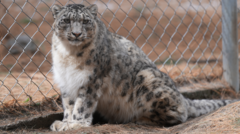The plight of the snow leopard, with a population of just 4,000 to 6,000 in the wild, faces significant threats from habitat loss and human-wildlife conflict. In an effort to mitigate these dangers, the World Wide Fund for Nature (WWF), in collaboration with Pakistan's Lahore University of Management Sciences (LUMS), has developed a new approach: AI-powered cameras designed to alert villagers of snow leopard presence.
The AI cameras, installed in rugged mountain terrains of Gilgit-Baltistan, operate on solar power and serve to detect snow leopards, providing real-time alerts to farmers about their livestock’s safety. Conservationist Asif Iqbal explained the technology's purpose, showcasing its ability to differentiate between humans, animals, and the elusive big cats.
For the project to succeed, community cooperation is crucial. Initially met with skepticism, some villagers questioned the technology's effectiveness. WWFs attempt to educate the locals about the ecological importance of snow leopards, which help maintain the balance of their ecosystem by controlling prey populations, has met with mixed reactions. While some embrace the conservation message, others remain wary, citing livestock losses and the encroachment of climate change on traditional grazing lands.
The initiative has experienced technical hurdles as well. The team has faced issues with battery durability during harsh winters and had to be sensitive to cultural practices regarding privacy. This has led to relocation of cameras and other operational challenges. However, as local understanding of the program evolves, the WWF continues to seek binding agreements from farmers to not share camera footage with poachers.
In a community meeting, older villagers noted a shift in attitudes over time, recognizing that snow leopards contribute positively to their ecosystem. Yet, not all local farmers are convinced. Some report major livestock losses to predation, which they attribute to the presence of both snow leopards and ibex.
While legal measures have deterred poaching, the WWF acknowledges that the AI cameras cannot single-handedly resolve the complexities surrounding wildlife conservation in this region. Future trials with scents, sounds, and light deterrents are planned in an effort to keep snow leopards away from farm areas.
As conservationists strive to protect these 'ghosts of the mountains,' the efforts to coexist peacefully between wildlife and farming communities will undoubtedly require patience, understanding, and innovative solutions.






















